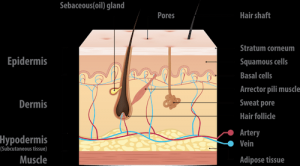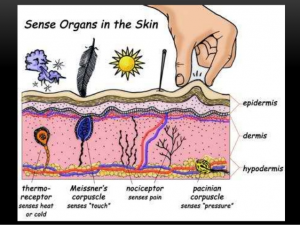Skin is one of the largest and most active organs, which is a must for any life. It is on the surface of the body to prevent us from the damage and pollution of the outside world.
What is the composition and structure of the skin?
The area: The skin is equivalent to a whole 1.5~2.0㎡dress, which is an armor to protect our physical health. Only a minor cut on the body can lead to lots of harmful bacteria and viruses that cause inflammations or severe adverse reactions.
The area of skin= Height*Width of shoulder*2.
Weight: 15% of body weight.
Thickness: 0.5~4.0mm. The skin of the eyelid and behind the ear is the slimmest. The skin of palms and the soles of feet is the thickest.
Color: It’s subject to race, age, male, different physical parts, and environment.
Texture: As we know, the texture per person is different. That’s why fingerprint identification is used in various places.
Structure: the epidermis, the dermis, and the hypodermis from the top down.
How does the skin work?
The epidermis is the most outer component of skin and this is the part that we see and typically associate with skincare. The dermis is the layer of skin directly below the epidermis and is responsible for providing needed nutrients to the epidermis along with removing waste products. The third layer of the skin is the hypodermis layer and is responsible for keeping the other two layers securely attached to the body.

What’s the function of the skin?
-
A barrier
As a barrier, the skin can prevent the injuries of the outside world and the loss of nutrition, electrolytes and water inside the body.
Usually, there are injuries as the following:
- Mechanical injury.
- Physical injury.
- Chemical injury. The cuticle is the main role to prevent this kind of injury.
- Biological injury. Such as microorganisms would become germs and damage the health.
-
Adjust the physical temperature
The physical body has a perfect temperature adjustment mechanism, of which the skin is an effector to carry out the instructions.
When it’s hot weather, the amount of blood flow increases and more heat would be taken out from inside to the surface.
When it’s cold weather, the body would produce more heat and the amount of blood flow reduces. This helps the body to maintain a normal temperature.
-
Sensory organ
The normal skin can have 6 senses: touch, pain, cold, warm, pressure sense, and itching. Additionally, the skin also have complex feeling such as wet, dry, soft, smooth, etc.

-
Secretion&excretion
This function mainly depends on the sebaceous gland and sweat gland.
-
Absorption
The ability of the skin to absorb external substances is called transdermal absorption, which is an indispensable ability to maintain good health, and is also the theoretical basis for modern dermatology external medicine to treat skin diseases.
-
Immunization
Most people may think the skin only works as an external barrier for the physical body, and do little on the immunization. However, the experts found the skin has a very strong immunization, which is a unique immune organ.
The heath of skin is an important part for us. Protect them it to protect your health and beauty.

2 Comments